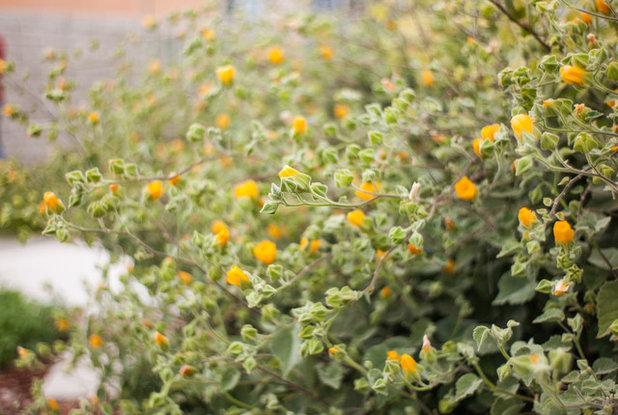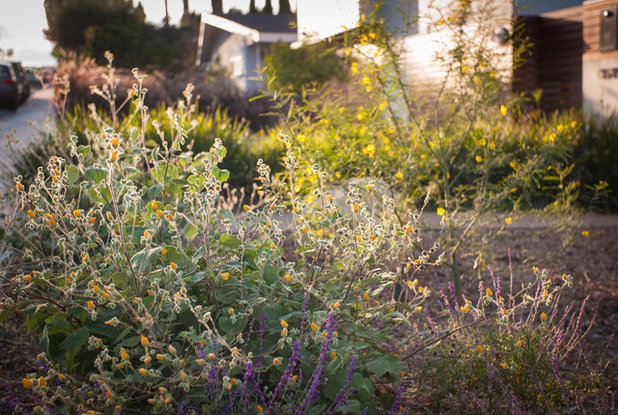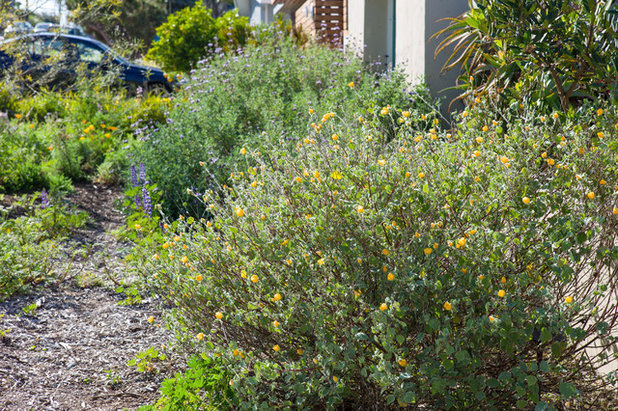Sun-loving Palmer’s Indian mallow (
Abutilon palmeri) dazzles with nearly year-round blooms and requires very little water once established. With golden orange flowers, velvety green foliage and striking red stems, this attractive shrub looks great as a single specimen or en masse. The flower nectar feeds butterflies and hummingbirds, and sculptural dried seedpods make great forage for songbirds. It’s a win-win plant for wildlife and people.
Not in the Southwest? Browse plants native to other regions of the U.S.

Oakley Gardens
Botanical name: Abutilon palmeriCommon names: Palmer’s Indian mallow, Indian mallow, flowering maple
Origin: Deserts of California, Arizona and northern Mexico; adjacent Peninsular Ranges
Where it will grow: Frost tender; may tolerate temperatures down to 25 degrees Fahrenheit, or minus 3.9 degrees Celsius (USDA zones 9b and higher; find your zone)
Water requirement: Drought-tolerant to occasional water

Oakley Gardens
Light requirement: Full sun
Mature size: 4 to 5 feet tall and wide
Benefits and tolerances: This plant, originally from desert areas, thrives in full sun and can tolerate hot temperatures in a variety of soil types, including clay. Once it is established (usually after the first year), it is considered drought-tolerant and looks lush with a minimal amount of water.
Seasonal interest: Palmer’s Indian mallow flowers roughly March through October, tapering off in the winter. Its red stems stand out when the intricate seedpods dry.
When to plant: This desert plant may be planted almost year-round. Hot areas like Southern California should plant it in the cool season (late October through February) to utilize winter rains and cooler temperatures during its establishment period.

Oakley Gardens
Distinguishing traits. Delicate, lantern-shaped golden orange flowers open and close with the rising and setting of the sun. Large heart-shaped leaves are fuzzy and delightful to touch, and striking red stems make this plant a pleasure to prune. The dried fruits appearing late summer through fall are sculptural seedpods that feed several bird species and make for beautiful
ikebana, the Japanese art of flower arrangement.
Shown: Palmer’s Indian mallow grows next to Mexican bush sage (
Salvia leucantha).

Oakley Gardens
How to use it. Plant it in a hot, sunny spot in your garden and prune for desired shape in the fall. Palmer’s Indian mallow is gorgeous planted in masses and drifts in larger garden spaces where afternoon light dances in its velvety light green leaves. It’s also an excellent container plant, thriving in a medium to large container with a potting mix for cactuses and succulents.
Planting notes. This shrub grows fast and is worth starting from a 1-gallon pot (Southwest gardeners should check their local native plant nursery). If the conditions are right in your garden, Palmer’s Indian mallow may reseed, and you can transplant young seedlings to desired locations.
Prune spent flower stalks — called deadheading — to encourage more blooms. Prune for shape and remove spent flower stalks during the cooler winter months.





